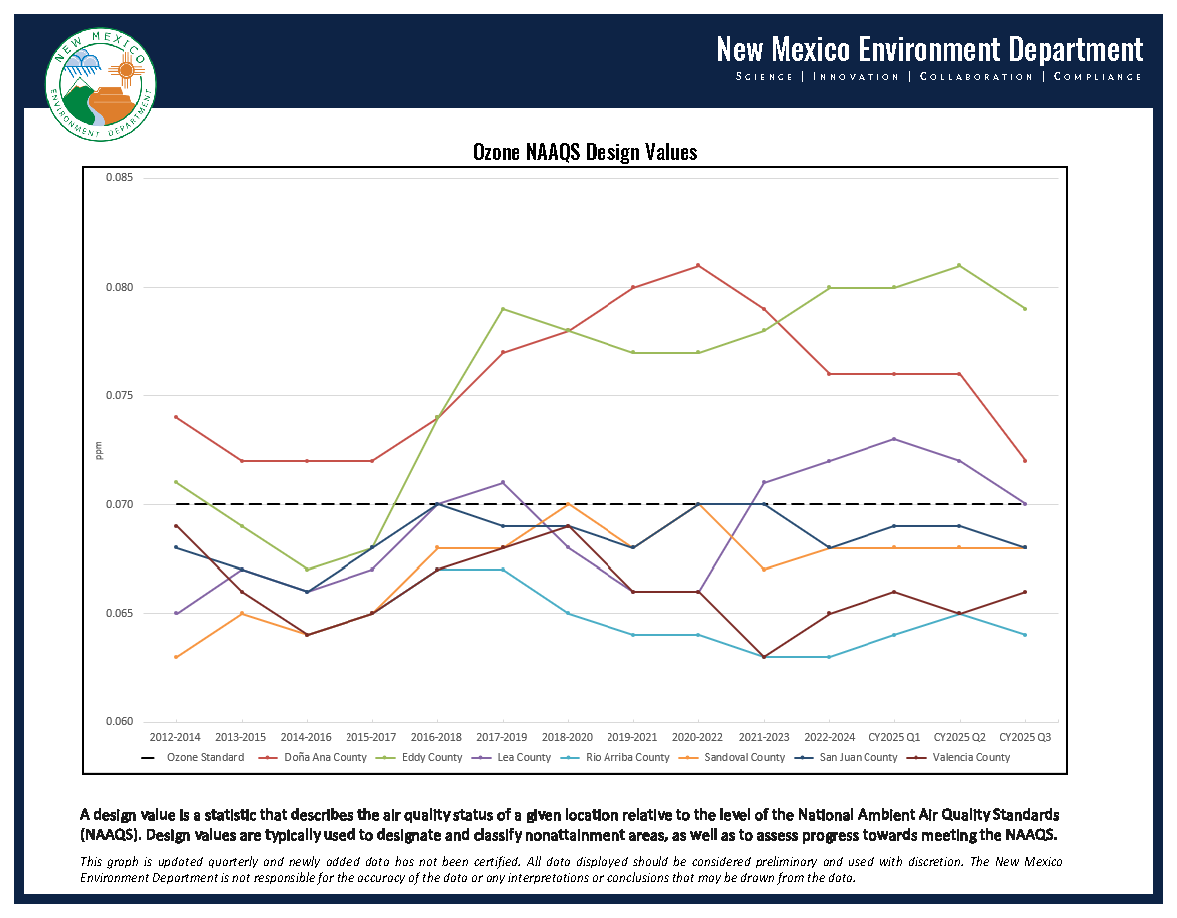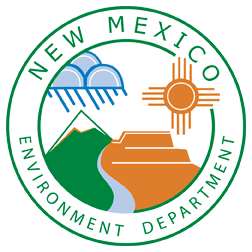The Environment Department operates a network of ambient air monitors that continually sample the air across New Mexico, except for Bernalillo County and tribal lands. The NMED Air Monitoring page contains photos of the monitoring sites and information about what pollutants we monitor and their potential health effects. The City of Albuquerque/Bernalillo Air Quality Division monitors air pollutants and pollen in Bernalillo County. Visit the City of Albuquerque website for additional information.
Below is information for the public on some of the air pollutants in New Mexico:
Asbestos
Asbestos is a common fibrous rock found worldwide that has been used in thousands of products, including textiles, paper, ropes, wicks, stoves, filters, floor tiles, roofing shingles, clutch facings, water pipe, cements, fillers, felt, fireproof clothing, gaskets, battery boxes, clapboard, wallboard, fire doors, fire curtains, insulation and brake linings. Asbestos is a common mineral in New Mexico, but is not problematic is the fibers are not released into the air.
When asbestos gets into the lungs, it can cause serious health impacts, including lung cancer. There are regulations that apply when handling or disposing of asbestos. More information on asbestos regulations in New Mexico is available on our website.
Ozone
Ozone (O3) is a gas composed of three atoms of oxygen that occurs in the Earth’s upper atmosphere and at ground level. Ground level ozone is a harmful air pollutant. Ozone also contributes to the formation of haze, which detracts from the beautiful views we cherish here in New Mexico.
Click the links below to find out more information about:
- Air Quality Issues in Dona Ana County describes the history and regulation of dust and ozone in Doña Ana County.
- Health Effects of Ground Level Ozone describes the consequences of breathing ozone.
- How Ozone is Formed describes the origin and chemistry of ozone formation.
- New Mexico’s Ozone Attainment Initiative describes actions taken to keep New Mexico in attainment of ozone standards.
- Regional Haze provides many resources related to preventing hazy skies.
- Sunland Park Ozone
- Nonattainment Area Plans Document Collection provides the basis and conclusion for the Sunland Park ozone plan.

Historical Ozone Monitoring Data provides the background data for the figure above.
Particulate Matter
Particulate matter (PM) is a collective term for a complex mixture of extremely small solid particles and liquid droplets suspended in the air. This mixture is also referred to as particle pollution or soot. Sources of particulate matter include smoke and windblown dust. The sizes of particulate matter that can reach the lungs are regulated through National Ambient Air Quality Standards. “PM2.5” means particulate matter with an aerodynamic diameter less than or equal to a nominal 2.5 micrometers. “PM10” means particulate matter with an aerodynamic diameter less than or equal to a nominal 10 micrometers.
PM2.5 Attainment Status
Revised 2024 PM2.5 National Ambient Air Quality Standard Attainment Designation Recommendation was submitted to EPA to convey New Mexico’s conclusions that New Mexico attains the updated PM2.5 NAAQS.
Particulate Matter Exceptional Events Demonstrations
NMED documents that certain exceedances of particulate matter air quality standards were caused by dust storms generated by high winds, rather than man-made sources. Without these demonstrations, certain areas of the state would be in violation of the federal standards and subject to stricter air quality rules and requirements designed to meet and maintain the standard in the future. The level of the federal air standards for particulate matter are protective of public health. Exceptional event demonstrations are available.
Smoke
Smoke from wildfires affects air quality and can have negative health impacts. The Wildfire Smoke Factsheet includes information on how you can prepare for and take actions to protect yourself from wildfire smoke. Current wildfire information is available on the New Mexico Fire Information website.
Federal Land Managers (such as the Forest Service, Bureau of Land Management, and Fish and Wildlife Service) monitor smoke from some prescribed burns and wildfires. For real-time monitoring data, visit https://fire.airnow.gov/.
More information about controlled burns, which must be registered through the Environment Department, is available on the Smoke Management Program page.
More information about open burning is available.
Windblown dust
Dust in the air, a type of particulate matter, is a type of air pollution that can be created when winds are at high speeds.
The U.S. Environmental Protection Agency sets standards for particulate pollution, and the New Mexico Environment Department is responsible for monitoring and enforcing those standards. When winds are high and dust storms occur, dust in the air can become a serious health concern and safety issue. Windblown dust may be naturally occurring but can be contributed to by human activities, like construction.
Dust can irritate sensitive lung tissue and cause health problems, especially in vulnerable populations including infants, children, teens, the elderly and pregnant women; people with asthma, bronchitis, emphysema, or other respiratory conditions; and people with heart disease. Healthy adults working or exercising outdoors may also be affected by these high concentrations of dust.
When dust is causing poor air quality, the best precaution to take is simply to avoid going outside during severe dust storms. If you must go out, spend as little time outside as possible, and avoid hard exercise. Wearing a covering over your nose and mouth can provide some protection from large particles. The Dust Storms and Health pamphlet describes precautions to take and other dust storm information.
Historically, the State has seen the issue of dust as a local issue that should be regulated on the local level. If you have a complaint about windblown dust caused by human activity, contact your local and/or county government, which may have ordinances in place that address windblown dust. Contact the Environment Department at 1-800-224-7009 so we can document your complaint.
As part of the Southern Doña Ana and Luna County Dust Mitigation Plan the Air Quality Bureau hosts a Dust Symposium during the spring/fall as an opportunity for the local and regional stakeholders to meet to discuss the latest findings in dust research and mitigation projects. Information to join the next meeting follow.
- 2025 Spring Dust Symposium Agenda outlines the topics and speakers of the April 22, 2025 meeting.
Videos and notes from previous Southern New Mexico Dust Symposiums follow.
- Southern NM Dust Symposium, October 31, 2022 (1 hour 53 min)
- Southern NM Dust Symposium Agenda (October 31, 2022)
- Southern NM Dust Symposium, May 9, 2023 (4 hours 6 minutes)
- Southern NM Dust Symposium Agenda (May 9, 2023)
- Southern NM Dust Symposium Agenda (April 30, 2024)
- Southern NM Dust Symposium, April 30, 2024 (3 hours 58 minutes)
- Southern NM Dust Symposium, April 22, 2025 (3 hours 25 minutes)
Additional dust-related resources are available:
- Air Quality Issues in Dona Ana County describes the history and regulation of dust and ozone in Doña Ana County.
- Doña Ana County Dust Plan Document Collection provides the basis and conclusion for the Doña Ana County dust plan and nonattainment plan.
- Dust Control Resources Collection provides references of dust control techniques.
- High Wind Fugitive Dust Mitigation Plan for Doña Ana and Luna Counties provides the final 2020 plan for these counties.
- Luna County Natural Events Action Plan Document Collection provides the basis and conclusion for the Luna County dust plan.
- Sources and Solutions for Windblown Dust describes particulate matter sources and dust control measures.

